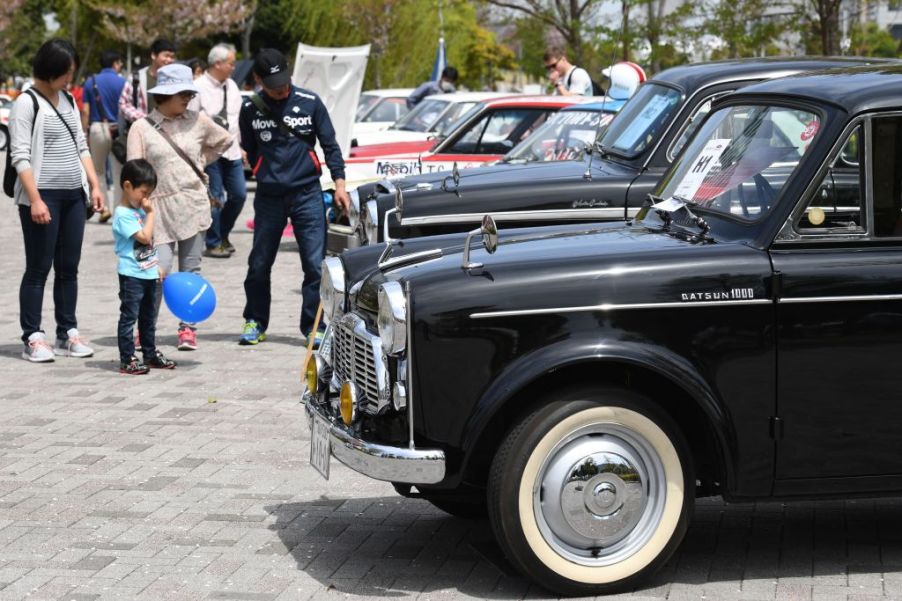
The First Compact Pickup Truck Was an Unusual But Efficient Import
When the Datsun pickup truck first caught the eye of former U.S. Navy serviceman Richard McCrutcheon in 1959, he was determined to own it. Having been stationed in Japan, he was familiar with the brand. Finally, the veteran caught up with the tiny pickup at the San Diego Datsun dealership, where he struck a bargain with owner Ray Lemske.
Datsun’s parent company, Nissan, marketed it as a commercial vehicle. Soon, the quirky-looking Datsun 1000 became a staple for Southern California gardeners and beyond. Named for its 1000cc, 37-hp four-cylinder type C engine, the 1000 had a simple design and four-speed manual transmission.
The Datsun 1000 transforms the U.S. pickup truck market
When the first Datsun 1000 landed on American soil, the tiny compact’s competition was large and gas-guzzling. Belying its tiny presence was a formidable opponent for its massive eight-cylinder American counterparts.
McCrutcheon had firsthand experience with the Datsun as a solid, dependable vehicle. In 1957, Datsun hired American engineer Donald Stone to design a “new engine based on the current Austin B Series.” Datsun’s “stone engines” were a vast improvement, with a seal created at the end of the crankshaft as one of the most notable.

Each year the small pickup was in production, Nissan made improvements and added more power to its engine. When Model 320 premiered in 1961, it was equipped with a 1200 cc, E-Series, 60-hp engine. It also replaced the solid beam axle with a torsion bar independent front suspension.
The 520 was introduced in 1965 and featured another modification to the “stone engine.” The OHV four-cylinder J-Series engine increased to 1300 cc with 67 hp. New styling included a roomier cab.
When Nissan presented the restyled 521 pickup to the American market in 1969, it was equipped with an L-series 1600 cc, OHC four-cylinder engine producing 96 hp. At this point, Nissan’s market had expanded beyond California with annual sales at $30,000. Around this time, Toyota began to make inroads in the American market.
The L18 engine designed for Datsun’s 1974 620 pickup sported 100 hp, and by 1975 it increased to 110 hp. A king cab was an option beginning with the 1977 models. Other choices available the same year included a five-speed manual or automatic transmission.
The 1979 Datsun 720 rolled into the North American market with a four-door king cab and longer truck bed. The front grille and headlight shape and dimensions changed. Two-wheel and four-wheel-drive were available options.
Production of the 720 occurred at the Smyrna, Tennessee plant from 1980 until 1986. Then, Nissan moved production to Mexico where the pickup was discontinued in 1991.
True compact truck production vanishes in North America after the mid-’90s
While a number of four-cylinder pickup trucks occupy the current U.S. marketplace, they are markedly larger than the original Datsun compacts. In fact, U.S. News & World Report’s Best Pickup Trucks for 2019 included the 2019 Honda Ridgeline and Ford Ranger as well as 2020’s GMC Canyon, Chevrolet Colorado, Toyota Tacoma, and Nissan Frontier.
They qualify as compact models by today’s standards. However, they more accurately offer mid-size truck capabilities with full-size dimensions.
Offered in four-cylinder and six-cylinder variations, each model easily provides more horsepower than its compact predecessors. The 2.7-liter, four-cylinder Tacoma, for example, offers 159 hp. Compared to Datsun’s peak 110 hp, it’s a significant boost.
The compacts of yesterday were also a more affordable entry into vehicle ownership. Many established adults have a difficult time pulling together the funds to buy a truck these days. With ever-increasing gas prices and environmental burden, the dormant mini-compact truck market seems poised for a rebirth.


